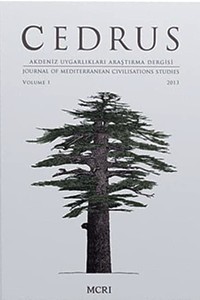KÜÇÜK ASYA’DAKİ LİVİA PORTRELERİ
Bu çalışmada, Roma İmparatorluğu’nun doğudaki en önemli eyaletlerinden birisi olan Küçük Asya’da ele geçmiş Livia portreleri tipolojik acıdan ele alınacaktır. Söz konusu eserler, bugüne kadar Livia portrelerini konu alan birçok çalışmada ele alınmıştır. Ancak konu ile ilgili en kapsamlı ve güncel yayın, E. Bartman’a aittir. Araştırmacı yayınında adı geçen coğrafyadaki portreleri Marbury Hall tipinin birer varyantı olarak kabul etmiştir. Ancak tarafımızca yapılan gözlemler, bu portrelerin Fayumtipini de ayırt edici özelliklerine sahip olduklarını ve hatta bu iki tipe yabancı unsurları da taşıdıklarını ortaya koymuştur. Makalede öncelikli olarak bu iki tipin ayırt edici özelliklerinden bahsedilecek, ardından Küçük Asya eserlerinin bu tiplerin hangi özellik/özelliklerine sadık kalınarak uygulama bulduğu üzerinde durulacak ve yabancı unsurlar için de öneriler sunulacaktır.
Anahtar Kelimeler:
Livia • Portre • Marbury Hall Tipi • Fayum Tipi • Küçük Asya
PORTRAITS OF LIVIA IN ASIA MINOR
This article treats from a typological perspective the portraits of Livia, portraits originating from the major eastern provinces of the Roman Empire, as also from Asia Minor. These portraits have already been analysed in scholarly works. In this respect E. Bartman has presented the most recent and comprehensive scientific analysis. The author has stated that the portraits in question were variants of the Marbury Hall statuary type. However, observation shows these portraits carry the characteristics of more than one portrait-type, for example of the Fayum type. In addition, they have completely different elements from this type. The following article first addresses the differences between the two types and subsequently, the question is discussed, as to which characteristics of these types can be observed in the Livia portraits from Asia Minor. Finally, the postulated different elements arestated.
___
- Alexandridis 2004 A. Alexandridis, Die Frauen des römischen Kaiserhauses. Eine Untersuchungen ihrer bildlichen Darstellung von Livia bis lulia Domna. Mainz am Rhein 2004.
- Alzinger 1972 W. Alzinger, Die Ruinen von Ephesos. Wien 1972.
- Aurenhammer 1983 M. Aurenhammer, “Römische Porträts aus Ephesos. Neue Funde aus dem Hanghaus 2”. Öjh 54 (1983) 105-146.
- Aurenhammer 1988 M. Aurenhammer, “Römische Porträts aus Ephesos”. Eds. N. Bonacasa G. Rizza, Ritratto ufficiale e ritratto privato: atti della II Conferenza internazionale sul ritratto romano, Roma, 26-30 Settembre 1984. Roma (1988) 123-130.
- Bartman 1999 E. Bartman, Portraits of Livia. Imaging the Imperial Woman in Augustan Rome. Cambridge 1999.
- Boschung 2002 D. Boschung, Gens Augusta: Untersuchungen zu Aufstellung, Wirkung und Bedeutung der Statuengruppen des julisch-claudischen Kaiserhauses. Mainz am Rhein 2002.
- Eichler (1964-1965) F. Eichler, “Türkei, Ephesos”. Öjh 47 (1964-1965) 5-12.
- Erim 1975 K. T. Erim, “Aphrodisias in Caria. The 1973 Campaign”. TürkAD 22/2 (1975) 73-92.
- Erkoç 2012 S. Erkoç, Anadolu’da Iulius-Claudiuslar Dönemi Portre Sanatı. Yayımlanmamış Doktora Tezi, Akdeniz Üniversitesi. Antalya 2012.
- Erkoç 2013 S. Erkoç, “Anadolu’daki Iulius-Claudiuslar Dönemi Portreleri: Hellenistik Geleneğin İzleri?”. Cedrus I (2013) 219-240.
- Fittschen – Zanker 1983 K. Fittschen – P. Zanker, Katalog der römischen Porträts in den Capitolinischen Museen und den anderen kommunalen Sammlungen der Stadt Rom III: Kaiserinnen und Prinzessinnenbildnisse. Mainz 1983.
- Gauckler 1910 P. Gauckler, Catalogue Du Musée Alaoui. Paris 1910.
- Hahn 1994 U. Hahn, Die Frauen des römischen Kaiserhauses und ihre Ehrungen im griechischen Osten. Saarbrücken 1994.
- İnan – Rosenbaum 1966 J. İnan – E. Rosenbaum, Roman and Early Byzantine Portrait Sculpture in Asia Minor. London 1966.
- İnan – Rosenbaum 1979 J. İnan – E. A. Rosenbaum, Römische und Frühbyzantinische Porträplastik aus der Türkei. Mainz 1979.
- Koçak 2016 M. Koçak, “Dansa Davet? İki Heykel Başı Üzerine Düşünceler”. Olba XXIV (2016) 323-339.
- Kreikenbom 1992 D. Kreikenbom, Griechische und römische Kolossalporträts bis zum späten ersten Jahrhundert nach Christus. Berlin 1992.
- Kuttner 1995 A. L. Kuttner, Dynasty and Empire in the Age of Augustus. Berkeley 1995.
- Poulsen 1968 V. Poulsen, “Drei antike Skulpturen im Residenz-Museum München”. MüJb 19 (1968) 9-28.
- Rose 1997 C. B. Rose, Dynastic Commemoration and Imperial Portraiture in the Julio-Claudian Period. Cambridge 1997.
- Smith 1987 R. R. R. Smith, “The Imperial Reliefs from the Sebasteion at Aphrodisias”. JRS 77 (1987) 88-138.
- Smith 1988 R. R. R. Smith, Hellenistic Royal Portraits. Oxford 1988.
- Smith 2006 R. R. R. Smith, Aphrodisias II. Roman Portrait Statuary from Aphrodisias. Mainz am Rhein 2006.
- Smith – Erim 1991 R. R. R. Smith – K. T. Erim, “Sculpture from the Theatre: A Preliminary Report”. Eds. R. R. R. Smith – K. T. Erim, Aphrodisias Papers 2: The Theatre, A Sculptor’s Workshop, Philosophers, and Coin-Types, JRA Suppl. 2. Ann Arbor (1991) 67-98.
- Smith – Lenaghan 2009 R. R. R. Smith – J. L. Lenaghan, Aphrodisias’tan Roma Portreleri. İstanbul 2009.
- Vetters 1981 H. Vetters, “Ephesos. Vorläufiger Grabungsbericht 1980”. AnzWien 118 (1981) 137-168.
- ISSN: 2147-8058
- Yayın Aralığı: Yıllık
- Başlangıç: 2013
- Yayıncı: Akdeniz Üniversitesi
Sayıdaki Diğer Makaleler
Anadolu’da Pers Satraplık Sistemi
GÖYNÜK VE MUDURNU’DAN YENİ YAZITLAR IV
KÜÇÜK ASYA’DAKİ LİVİA PORTRELERİ
Doğu-Batı İlişkilerinde Türk Denizciliği: Anadolu Jeopolitiği
HERODOTOS’UN ANLATIMLARINA GÖRE, İSKİTLERİN KİMMERLERİ TAKİP MESELESİ
KAPPADOKIA STELLERİ ÜZERİNDEKİ ARGAIOS ERCİYES DAĞI BETİMLEMESİ
SİLİFKE MÜZESİ’NDEN MİTOLOJİK FİGÜRLÜ KAMEOLAR VE GEMMELER
Antik Hellen Tapınağı ve Kutsal Alanlarında Tasarım ve Düzenlemeler
ROMA’NIN KUZEY DOĞU SINIRINDA TİCARET, STRATEJİ VE ULAŞIM
